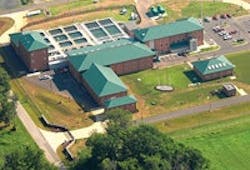Water Treatment Plant Sets State Standard for Use of Filtration, Disinfection Technologies
Murfreesboro, Tenn., is known as one of the fastest growing cities in the U.S., with a population that has grown more than 120% since 1990. As a result, Murfreesboro Water and Sewer Department commissioned the 20-million-gal-per-day (mgd) Stones River Water Treatment Plant, enlarging and upgrading the facility to be the largest membrane filtration plant, largest on-site sodium hypochlorite generation facility and the only lime softening water treatment plant in Tennessee.
The plant, which was first constructed in 1967 and averaged 10.6 mgd prior to expansion, is also one of the only facilities in the world with the capability to utilize granular activated carbon either before or after membrane filtration to enhance microbial reduction, improve taste and remove odors.
According to Alan Cranford, the water and sewer department's superintendent of water treatment, the plant's expansion and improvements were precipitated by three factors.
"While we had upgraded the plant several times since its original commissioning, some of the equipment was 40 years old. And with the rapidly growing population in this part of the state, we needed to expand the plant's capacity,” Cranford said. “Lastly, we wanted to be proactive about preparing for anticipated new U.S. Environmental Protection Agency regulations relating to water treatment. For example, many water utilities are moving from sand filtration to membrane filtration to more effectively control organics and Cryptosporidium at lower cost."
Natural conditions, turbidity and water hardness in the Murfreesboro area posed two treatment challenges for the Stones River expansion project. The Stones River plant draws some of its source water from a stream that has elevated levels of turbidity during rain events.
"During heavy rain storms, turbidity can rise dramatically," Cranford said. "Before the installation of the new plant, it was not uncommon to have finished water turbidity levels of 0.1 to 0.2 NTU.” In addition, the geology of the region resulted in naturally hard groundwater supplies. As a result, a lime softening technology had to be incorporated into the upgraded plant.
The key companies involved in the plant's upgrade were the design engineer, Smith Seckman Reid Inc.; the general contractor, Building Crafts Inc.; the electrical contractor, Wolfe & Travis Electric Co.; and systems integrator, M/R Systems.
"When Smith Seckman Reid investigated the most appropriate on-site system for the Stones River plant, they considered simplicity of operation and maintenance,” Cranford said, “Selecting a system that had a proven track record in larger facilities was important, too."
Pilot Testing
The system selected was the ClorTec on-site sodium hypochlorite generating system from De Nora Water Technologies. The system includes two 900-lb-per-day hypochlorite generators that are kept in operation concurrently, giving the facility redundancy in the event one unit temporarily ceases operation; two 40-ton brine silos; and three 15,000-gal storage tanks.
The ClorTec system works by feeding softened water into a brine dissolver. A brine solution is formed, which is further diluted to a consistent 0.8% solution. The salt solution is then passed through electrolytic cells, which apply a low-voltage DC current to the brine to produce the sodium hypochlorite solution. The sodium hypochlorite solution, a chlorine equivalent, is then safely stored in the storage tanks. When it reaches the low-level set point, the system automatically restarts to replenish its supply. Three liquid feeders inject the sodium hypochlorite as needed into the distribution system to maintain the disinfection demand.
Generating a sodium hypochlorite disinfectant at the plant without the use of chemicals eliminates potential hazards associated with transportation and storage. And unlike bulk sodium hypochlorite, which degrades with exposure to ultraviolet light, the 0.8% sodium hypochlorite solution is stable.
Full-Scale Operation
Since the plant's recommissioning, finished water turbidities have consistently been less than 0.02 NTU and total organic carbon reduction has improved by almost 33%—from 39% reduction to 55% reduction. The expanded facility has provided additional capacity for the rapidly growing community, while the facility upgrades have improved the security, operability and maintainability of the facility and improved the quality of the finished product.
As for the on-site sodium hypochlorite system, Cranford said: "The ClorTec system has proven to be simple to use and easy to maintain. And we've been impressed at the consistency of sodium hypochlorite solution it has produced. Compared to other on-site systems we investigated, the consistency of the solution has been outstanding."
